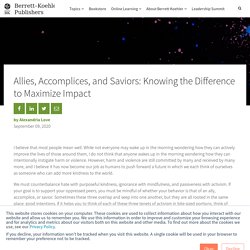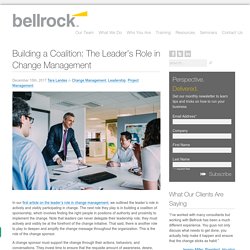

5 Ways to Help Sponsors Build a Coalition of Support for Change. One of the key roles of sponsors during any change is to build a coalition of support among important stakeholders in the organization.

With such a coalition, organizational changes are far more likely to succeed. Yet sponsors often fail to demonstrate support for the project in words and actions. Here’s how you can help your primary sponsor build the coalition of support your project changes need for success. the ABC's of Sponsorship When managing change, practitioners depend on executive leaders to perform the ABC's of effective sponsorship—an acronym for the three key roles a sponsor must perform to be an effective leader of change.
Of these critical activities, building a coalition of support can elude even the most well-intentioned sponsors. Why? Effective sponsor coalitions Although some changes are small enough that a single sponsor will suffice, most organizational changes impact multiple business groups and require multiple sponsors. Why build a sponsor coalition? 1. 2. 3. So What Exactly Is a “Coalition” Within an Organization? A Review and Organizing Framework (2020) Change Management and Your CAST of Characters. There is a simple truth about projects.

All projects result in change. Some projects bring about small modifications to the status quo, and others introduce a large-scale transformation. Many people in many roles will be affected by and instrumental in the change you’re promoting. It’s important to tend to their needs throughout the change journey. Allies, Accomplices, and Saviors: Knowing the Difference to Maximize Impact. I believe that most people mean well.

While not everyone may wake up in the morning wondering how they can actively improve the lives of those around them, I do not think that anyone wakes up in the morning wondering how they can intentionally instigate harm or violence. However, harm and violence are still committed by many and received by many more, and I believe it has now become our job as humans to push forward a future in which we each think of ourselves as someone who can add more kindness to the world.
We must counterbalance hate with purposeful kindness, ignorance with mindfulness, and passiveness with activism. If your goal is to support your oppressed peers, you must be mindful of whether your behavior is that of an ally, accomplice, or savior. Sometimes these three overlap and seep into one another, but they are all rooted in the same place: good intentions.
The Difference Between an Ally, an Accomplice, and a “Savior” Allyship, Reflection, and Inclusivity. So What Exactly Is a “Coalition” Within an Organization? A Review and Organizing Framework (2020) Il suffit de 10% des collaborateurs pour changer toute l'entreprise. Chroniques d’experts Organisation Le 23/09/2019 © Getty Images Temps de lecture : 6 minutes Pour porter une « transformation virale », il faut compter sur les convictions contagieuses des plus engagés.

Avec la prise de conscience massive des millennials, et d’une partie de plus en plus large d’individus, de l’impact de leurs choix et de leur consommation sur le climat et sur le monde, le sens que l’entreprise donne à ses activités, sa raison d’être et ses engagements en matière de responsabilité sociale et environnementale s’installent progressivement en avantages compétitifs majeurs sur le marché des talents comme sur celui des biens et des services. Oser reconnaître ceux qui s’engagent Oui, l’entreprise peut prendre sa part dans la résolution des urgences climatiques et sociales. Mais tout cela a un coût. Initier une « transformation virale » Bien choisir ces 10% 1. 2. 3. 4. Depuis de nombreuses années, j’ai la chance d’identifier, de soutenir et de réunir ces acteurs clés du changement. Core Roles in Change Management.
The ultimate goal of change management is to drive organizational results and outcomes by engaging employees and inspiring them to adopt a new way of working.

Whether the change is to a process, system, job role, organizational structure, or all of these, a project or initiative can only be successful if individual employees change their behaviors. This is the essence of change management. And to manage change successfully, all core roles must participate. A Coordinated System of Support Much like putting on a play—where actors, directors, costume designers, lighting and sound crews coordinate their unique talents to deliver a single successful outcome—change management requires individuals in key roles to engage with the change and coordinate their efforts in defined ways.
How to Effectively Build Out a Role Roster for Change. How to Effectively Build Out a Role Roster for Change. Building a Coalition: The Leader's Role in Change Management. In our first article on the leader’s role in change management, we outlined the leader’s role in actively and visibly participating in change.

The next role they play is in building a coalition of sponsorship, which involves finding the right people in positions of authority and proximity to implement the change. Note that leaders can never delegate their leadership role; they must actively and visibly be at the forefront of the change initiative. That said, there is another role to play to deepen and amplify the change message throughout the organization.